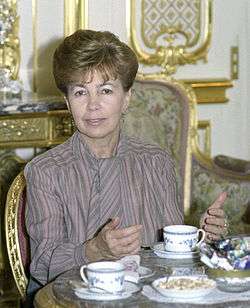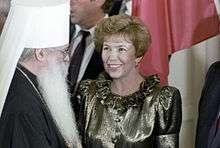Raisa Gorbacheva
| Raisa Gorbacheva | |
|---|---|
 | |
| Spouse of the President of the Soviet Union | |
|
In office 15 March 1990 – 25 December 1991 | |
| President | Mikhail Gorbachev |
| Spouse of the General Secretary of the Central Committee of the Communist Party of the Soviet Union | |
|
In office 11 March 1985 – 24 August 1991 | |
| Preceded by | Anna Chernenko |
| Succeeded by | Office abolished |
| Spouse of the Chairman of the Supreme Soviet of the Soviet Union | |
|
In office 25 May 1989 – 15 March 1990 | |
| Preceded by | Office established |
| Succeeded by | Ludmila Lukyanova |
| Spouse of the Chairman of the Presidium of the Supreme Soviet of the Soviet Union | |
|
In office 1 October 1988 – 25 May 1989 | |
| Preceded by | Lydia Gromyko |
| Succeeded by | Office abolished |
| Personal details | |
| Born |
Raisa Maximovna Titarenko 5 January 1932 Rubtsovsk, West Siberian Krai, Russian SFSR, USSR |
| Died |
20 September 1999 (aged 67) Münster, North Rhine-Westphalia, Federal Republic of Germany |
| Cause of death | Leukemia |
| Resting place | Novodevichy Cemetery |
| Spouse(s) | |
| Children | 1 |
| Alma mater | Moscow State University[1] |
| Profession | Philosopher |
Raisa Maximovna Gorbacheva (Russian: Раи́са Макси́мовна Горбачёва tr. Raisa Maksimovna Gorbachyova, née Titarenko, Титаре́нко; 5 January 1932 – 20 September 1999) was a Russian activist who was the wife of Soviet leader Mikhail Gorbachev. She raised funds for the preservation of Russian cultural heritage, fostering of new talent, and treatment programs for children's blood cancer.
Life and work
Raisa Maximovna Titarenko was born in the city of Rubtsovsk in the Altai region of Siberia. She was the eldest of three children of Maxim Andreyevich Titarenko, a railway engineer originally from Chernigov in Ukraine, and his Siberian wife, Alexandra Petrovna Porada, originally from Veseloyarsk. She spent her childhood in the Ural Mountains, and met her future husband while studying philosophy in Moscow. She earned an advanced degree at the Moscow State Pedagogical Institute, and taught briefly at Moscow State University.[2]

They married in September 1953 and moved to her husband's home region of Stavropol in southern Russia upon graduation. There, she taught Marxist–Leninist philosophy and defended her sociology research thesis about kolkhoz life. She gave birth in 1958 to their only child, Irina Mikhailovna (married name: Virganskaya; Ири́на Миха́йловна Вирга́нская). When her husband returned to Moscow as a rising Soviet Communist Party official, Gorbacheva took a post of a lecturer at her alma mater, Moscow State University. She left the post when her husband became a leader of the Soviet Union in 1985. Her public appearances beside her husband as first lady were a novelty at home and went a long way in humanizing the country's image. She was one of the few wives of a communist party leader to have a high public profile of her own.
On 1 June 1990, Gorbacheva accompanied U.S. first lady Barbara Bush to Wellesley College in Massachusetts. Both women spoke before the graduating class during the commencement service, touching on the role of women in modern society. All the American TV networks covered the addresses live; CNN provided live cable-TV coverage round the world. The events of the Soviet Coup of 1991 which attempted to depose her husband from power, left a lasting scar on Gorbacheva.[3] The political turmoil that followed pushed the Gorbachevs into the shadows.
Death and legacy

In 1989, following a personal address from Professor Rumyantsev and others, Gorbacheva contributed US$100,000 to the charity "International Association of Hematologists of the World for Children". This and further donations raised by both of the Gorbachevs helped to buy equipment for blood banks and to train Russian doctors abroad.
Gorbacheva suffered a stroke in October 1993.[4] However, in 1997 she went on to establish the Raisa Maksimovna's Club aimed at galvanizing the participation of women in politics. She also worked to raise awareness of children's issues (she had frequently welcomed youth delegations to the Kremlin when her husband could not be present).
In July 1999 she was diagnosed with leukemia by the Institute of Haematology RAMS. Shortly after, she travelled with her husband and daughter to Münster in Germany for treatment at the medical clinic of the Münster University Hospital. She received treatment for two months under the supervision of Professor Thomas Buechner, a leading haematologist. However, she died on 20 September aged 67. Her body was repatriated to Russia and interred at the Novodevichy Cemetery in Moscow.
In 2006, her family founded the Raisa Gorbacheva Foundation, which raises money to support those with childhood cancer.[5]
Books
References
- ↑ Gorbachev's Revolution, p. 55
- ↑ Watson, Robert P. (1 September 2000). The Presidents' Wives: Reassessing the Office of First Lady. Lynne Rienner Publishers. pp. 9–. ISBN 978-1-55587-948-8. Retrieved 15 June 2012.
- ↑ "The Gorbachev Files: Secret Papers Reveal Truth Behind Soviet Collapse". Spiegel.de. Retrieved 16 June 2012.
- ↑ Schmemann, Serge (3 November 1993). "Gorbachev, Energetic, Chatty, but Not Yet Political". The New York Times. p. 3.
- ↑ "Combatting Childhood Cancer". RG Foundation. Archived from the original on 11 February 2013. Retrieved 31 March 2013.
Sources
- "Transcripts of the Commemoration Meeting". 18 September 2000. Archived from the original on 27 September 2007.
- Raisa Gorbacheva biography at the Gorbachyov Foundation website
- Raisa Gorbachev's life in pictures, BBC News
- Profile of Alexandra Titarenko (Raisa Gorbachev's mother)
External links

- Appearances on C-SPAN